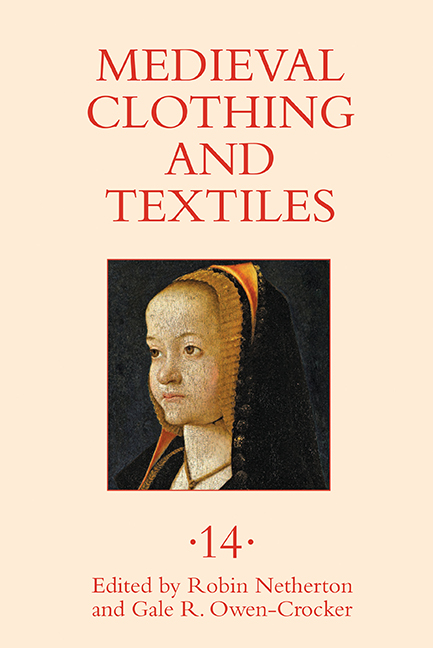Book contents
- Frontmatter
- Contents
- Illustrations page
- Tables
- Contributors
- Preface
- 1 Multicultural Clothing in Sixth-Century Ravenna
- 2 Byzantine and Oriental Silks in Denmark, 800–1200
- 3 The Bliaut: An Examination of the Evidence in French Literary Sources
- 4 Eyebrows, Hairlines, and “Hairs Less in Sight”: Female Depilation in Late Medieval Europe
- 5 Lexical Exchange with Italian in the Textile and Wool Trades in the Thirteenth to Fifteenth Centuries
- 6 Hidden in Plain Black: The Secrets of the French Hood
- Recent Books of Interest
- Contents of Previous Volumes
4 - Eyebrows, Hairlines, and “Hairs Less in Sight”: Female Depilation in Late Medieval Europe
Published online by Cambridge University Press: 13 July 2019
- Frontmatter
- Contents
- Illustrations page
- Tables
- Contributors
- Preface
- 1 Multicultural Clothing in Sixth-Century Ravenna
- 2 Byzantine and Oriental Silks in Denmark, 800–1200
- 3 The Bliaut: An Examination of the Evidence in French Literary Sources
- 4 Eyebrows, Hairlines, and “Hairs Less in Sight”: Female Depilation in Late Medieval Europe
- 5 Lexical Exchange with Italian in the Textile and Wool Trades in the Thirteenth to Fifteenth Centuries
- 6 Hidden in Plain Black: The Secrets of the French Hood
- Recent Books of Interest
- Contents of Previous Volumes
Summary
Late medieval and early modern art often depicts aristocratic women with arched plucked eyebrows, and foreheads with strikingly high manipulated hairlines. And when nudes appear, they frequently have no pubic or underarm hair. The artists’ evident concern to show these forms of hair removal reveals the influence of a powerful discourse at work about male-directed and -controlled canons of beauty. Variations in what is considered “fashionable” in clothing and appearance have, of course, existed at least since the late fourteenth century. But in this case, the evidence suggests that by the end of the Middle Ages, misogynistic scientific writing had made female body hair a psychic and physical danger to men, and for the woman, even a locus of anxiety about marriage prospects and fertility. With motivations thus ranging from simple vanity to fear of marital rejection, medieval women engaged in a variety of practices revealed by a surprisingly well-documented body of materials, methods, and practitioners to help them achieve their goals.
Cosmetic manuals, beginning with the ensemble of Latin texts known as Trotula in the late twelfth century and remaining popular through the sixteenth, offered instructions for reducing or removing hair on the face and even the genitalia (armpit hair seemed silently included in these recipes). These precepts seem to lie behind the medieval ideal of female hairlessness—a beauty and hygiene canon that apparently had widespread acceptance and internalization by both aristocratic women and those who wished, cosmetically at least, to appear like them. Such treatments of depilation offer not only a fascinating glimpse into cosmetic practices but also alert us to the existence of a class of professional depilators who traveled to homes, bathhouses, and courts to practice their craft.
Though medieval writing about female cosmetics has been examined by Monica Green, Claudio da Soller, and Montserrat Cabré, among others, and the female body has been recently treated in such works of art history as Sherry C. M. Lindquist's collection The Meanings of Nudity in Medieval Art, the topic of female depilation has not had close attention from cosmetic and fashion historians. This is surprising, since instructions for depilation, next to whitening the skin, are the most frequent recipes in the cosmetic manuals, which were almost all written by men though addressed to women, sometimes of high or royal social status.
- Type
- Chapter
- Information
- Medieval Clothing and TextilesVolume 14, pp. 81 - 112Publisher: Boydell & BrewerPrint publication year: 2018
- 1
- Cited by

